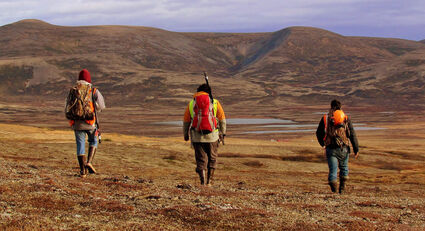EPA says no to Pebble pre-emptive veto
Will use established EIS mechanisms to address concerns North of 60 Mining News – August 2, 2019
Last updated 9/26/2020 at 5:15am

Pebble Limited Partnership
Workers traverse the world-class Pebble deposit on their way back to camp. In addition to 57 billion pounds of copper, 71 million oz of gold, more than 3 billion lb of molybdenum and 345 million oz of silver, the Pebble deposit is believed to host globally significant quantities of rhenium and tellurium, metals considered critical to the United States.
The United States Environmental Protection Agency has decided to roll back its 2014 proposed determination that, if finalized, would have placed debilitating restrictions on developing a mine at the world-class Pebble copper-gold-molybdenum project in Southwest Alaska.
Pebble Limited Partnership, the company that is advancing Pebble through permitting, hailed this decision to scrap the proposed pre-emptive veto of Pebble as a major win, not only for the future of its proposed mine but for the permitting of any large project in the U.S.
"Finally, this administration has reversed the outrageous federal government overreach inflicted on the state of Alaska by the Obama Administration," said Pebble Partnership CEO Tom Collier. "The pre-emptive veto was an action by an administration that sought to vastly expand EPA's authority to regulate land use on state, private and Native-owned lands throughout the United States, and in doing so kill one of America's most important mineral projects before a development plan was proposed or a comprehensive Environmental Impact Statement (EIS) permitting review was undertaken."
Opponents of the proposed mine, on the other hand, see the EPA decision as a setback in their efforts to keep large-scale mining out of the Bristol Bay region, an area of Southwest Alaska renowned for its world-class salmon fishery.
"This is unacceptable, and a clear example of politics taking priority over science at the federal level. The people of Bristol Bay deserve more from the federal government," said Bristol Bay Native Association CEO Ralph Andersen.
While EPA's decision to reverse its proposal to pre-emptively restrict any permits that could be issued for Pebble removes one obstacle for the mine proponent, the project must still make its way through a rigorous permitting process under National Environmental Policy Act.
NEPA requires proposed large projects such as Pebble to complete an environmental impact statement, which is vetted through a lengthy process that involves professional scrutiny and public input.
U.S. Army Corps of Engineers is the federal agency charged with leading the EIS process for Pebble.
EPA's Region 10 office, which has jurisdiction over Alaska, contends its decision to withdraw the pre-emptive veto is not an endorsement of the proposed Pebble Mine and it has other means to ensure that the EIS process addresses any concerns it has on potential unacceptable adverse impacts on fisheries resources in the Bristol Bay region.
"Region 10 has now concluded that it is more appropriate to use well-established mechanisms to raise project-specific issues as the record develops during the permitting process and consider the full record before potential future decision-making on this matter, instead of maintaining a Section 404(c) process that is now five years old and does not account for the voluminous information provided in the permitting process," it inked in its notice that it plans to withdraw its proposed determination.
One such mechanism is Section 404(q) of the Clean Water Act, which details a process for the EPA to lend its expertise to projects like Pebble, which require an EIS under CWA Section 404, while minimizing duplication and delays to issuing permits.
This mechanism puts Corps firmly in the driver's seat of Section 404 permitting but recognizes that EPA has unique expertise that are beneficial to the decision-making process. As such, this memorandum of understanding encourages "communication and full consideration of each agencies' views concerning proposed projects within the resource limits of each agency and the time constraints of the regulatory process."
With EPA's decision not to move forward with an Obama-era determination that would have usurped Corps CWA Section 404 authorities, the agency says it will now focus on analyzing the permitting data its fellow federal agency has compiled over the past 18 months.
"After today's action, EPA will focus on the permit review process for the Pebble Mine project," said EPA Region 10 Administrator Chris Hladick. "The agency has worked closely with the Army Corps to engage with stakeholders and the public on this issue, which has resulted in an expansive public record, including specific information about the proposed mining project that did not exist in 2014."
Alaska Miners Association Executive Director Deantha Crockett said this decision is good news for Pebble and Alaska.
"We are glad to see the EPA has removed this proposed determination and that fair and due process is back on the table for Pebble," she penned in a statement. "Development proposals must be stringently evaluated, and only fair reviews of project proposals will ensure continued investment in Alaska's economy."

Deantha Crockett
And, with Pebble being located on Alaska mining claims, the project will contribute to state coffers and provide another source of revenue for the Alaska Permanent Fund.
Pebble said the smaller, environmentally optimized mine it submitted for permit approvals is expected to generate tens of millions of dollars in state government revenues each year at a time when Alaska is facing a fiscal crisis. The proposed mine is also expected to support some 2,000 Alaska jobs, with an income average for the mine workers at Pebble topping $100,000 per year.
"This is a magnificent mineral deposit that would bring substantial revenues and jobs to Alaska at a time when we need both more than ever," Crockett said.
















Reader Comments(0)